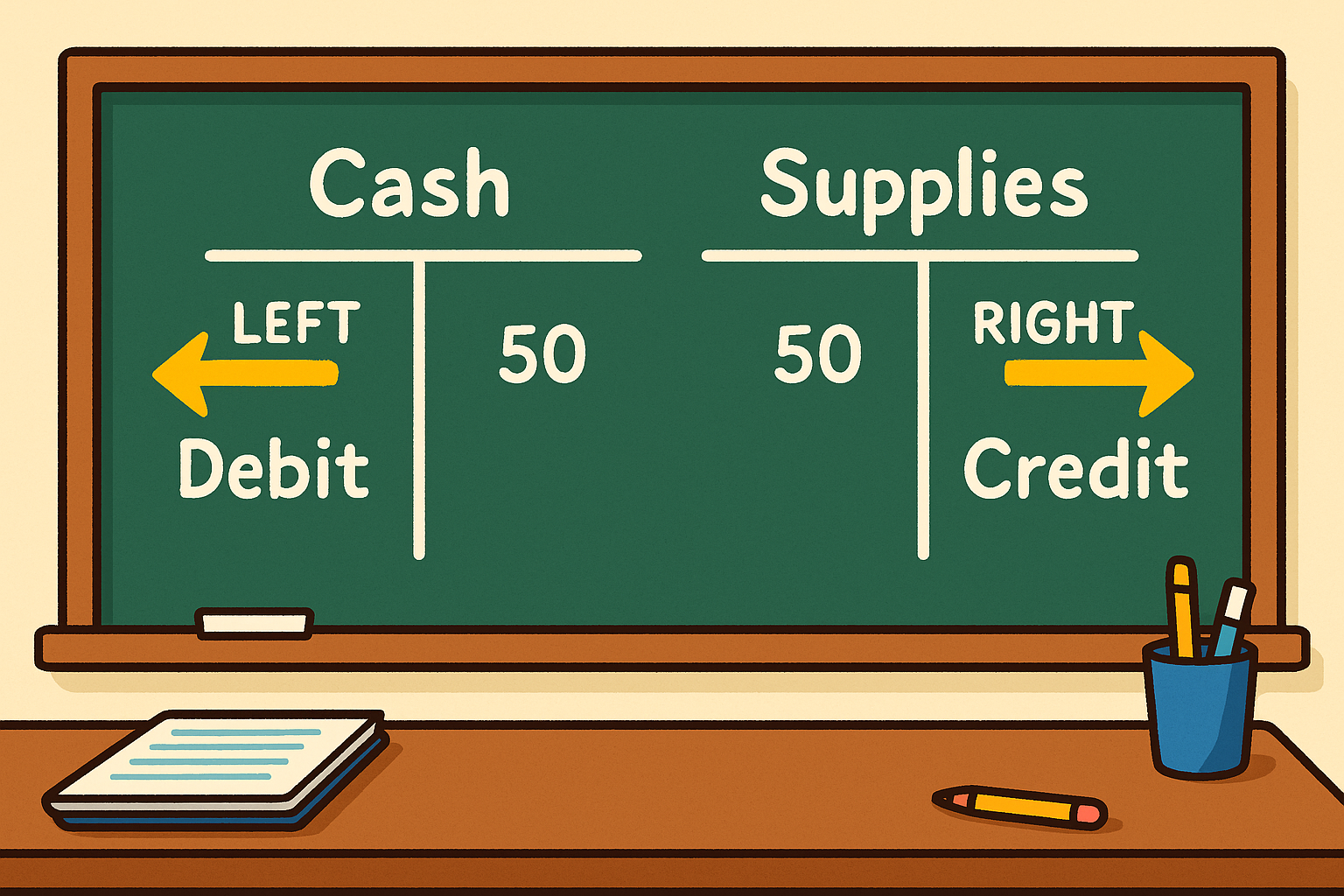🧮 Debits & Credits Explained
Before we can understand accounting, we have to learn its language.
And this language has two magic words: debit and credit.
They sound complicated — but they’re not.
They simply mean left and right in a financial table, and they always come in pairs.
Every transaction affects at least two accounts.
That’s why this system is called double-entry bookkeeping — one of the smartest ideas in business history.
⚖️ The Big Idea
Imagine your finances are a see-saw.
When one side goes up, the other goes down — perfectly balanced.
That’s exactly how accounting works.
Every time money moves:
- Something increases (we call it a debit)
- Something decreases (we call it a credit)
These two parts always match, keeping total value in harmony.
💡 Formula:
Every Debit must have an equal Credit.
🍞 Everyday Example
Let’s say you own a small café and you buy muffins for $50 in cash.
| What happens | Account | Type | Direction |
|---|---|---|---|
| You now have more muffins (inventory) | Supplies | Debit | +50 |
| You have less cash in the register | Cash | Credit | -50 |
Both sides equal $50.
You gained muffins (an asset), but lost the same amount of cash.
Nothing disappeared, it just changed form.
⚙️ Why This Matters
If you only tracked one side (say, the muffins), your books would say your business grew by $50 — which isn’t true.
You also spent $50 to get them!
Double-entry makes sure you see the full picture — where the money came from and where it went.
🏦 Another Example: Selling Cookies
Now let’s reverse it.
You sell a batch of cookies for $100 cash.
| What happens | Account | Type | Direction |
|---|---|---|---|
| You receive cash | Cash | Debit | +100 |
| You earn income | Sales Revenue | Credit | +100 |
Cash increases (left side), income increases (right side).
The total is balanced again.
📘 Every sale, expense, loan, or purchase works the same way.
🧾 The T-Account
Accountants often use a simple visual called a T-account — it literally looks like a letter “T”.
| Debit (Left) | Credit (Right) |
|---|---|
| Cash received | Cash spent |
| Assets increase | Liabilities decrease |
| Expenses | Income |
Each transaction touches at least two of these T-accounts — one on the left, one on the right.

The T-account structure — each transaction touches two sides: Debit (left) and Credit (right), always keeping the books balanced.
🧠 Quick Exercise
Think through these:
- You pay rent in cash — what goes up, what goes down?
- You buy a new laptop with your card.
- You receive payment from a customer.
- You take out a small loan from the bank.
If you can identify which account increases and which decreases — you already understand 90% of accounting.
🧩 Practice Table
| Transaction | Debit | Credit |
|---|---|---|
| You pay rent | Rent Expense | Cash |
| You sell cookies | Cash | Sales Revenue |
| You buy flour | Supplies | Cash |
| You take a bank loan | Cash | Bank Loan (Liability) |
Every line has balance — equal values on both sides.
Once you “feel” this symmetry, the rest of accounting becomes easy.
🌍 Real-World Perspective
This system was invented over 500 years ago by an Italian monk named Luca Pacioli.
It’s still used today — in every bank, startup, and multinational company.
Why?
Because it works.
It keeps financial information transparent, organized, and error-proof.
Even the world’s largest corporations rely on the same debit-credit logic you just learned.
💬 Remember:
Debits and credits aren’t “good” or “bad” — they just tell where money moves.
In the next lesson, you’ll see how all these movements come together in a snapshot called a Balance Sheet — the financial mirror of a business.
📝 Try this today
Write down 3 simple transactions (like buying snacks) and show what goes in and what goes out.
Explain to a friend why every transaction affects two accounts.
Create a 3-row T-account showing money moving in and out.
Lesson Progress
Module: accounting · +0% upon completion